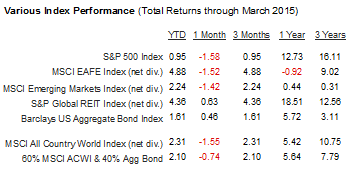The first quarter of the new year has
brought us small positive returns in many of the U.S. and global indices and
more than the usual amount of anxiety along with them. See below for common
market benchmark performance.
If you were watching the markets day to
day, you experienced a mild roller coaster, what trading professionals refer to
as a sideways market. One day it was up,
the next down, each day (or week) seeming to erase the gains or losses of the previous
ones. The best explanation for this
phenomenon is that investors are still looking over their shoulders at interest
rates, waiting for bond yields to jump higher, making bonds more competitive
with stocks and triggering an outflow from the stock market that could (so the
reasoning goes) cause a bear market in U.S. equities.
However, investors have been waiting
for this shoe to drop for the better part of three years, and meanwhile,
interest rates have drifted decidedly lower in the first quarter. The Bloomberg U.S. Corporate Bond Index now
has an effective yield of 2.93%. 30-year
Treasuries are yielding 2.48%, roughly 0.3% lower than in December, and 10-year
Treasuries currently yield 1.87%, down from 2.17% at the beginning of the
year.
This interest rate watch has created a
peculiar dynamic where up is down and down is up in terms of how traders and
stock market gamblers look at the future.
The generally positive economic news is greeted with dismay (The Fed
will notice and start raising rates sooner rather than later! Boo!) and any bad news sends the stock
market back up again into mild euphoria (The Fed might hold off another
quarter! Yay!).
The Fed’s future actions are
inscrutable. You will hear knowledgeable
Fed-watchers say that the Fed will take action as early as June or as late as
next year, and none of them really know.
We should all welcome the Fed pullback,
not fear it. A lot of the uncertainty
among traders and even long-term investors is coming from anxiety over how this
experiment is going to end. The U.S.
Central bank has directly intervened in the markets and in the economy, and is
still doing so. When that ends, normal
market forces will take over, and we’ll all have a better handle on what
“normal” means in this economic era. Is
there great demand for credit to fuel growth?
What would rational investors pay for Treasury and corporate bonds if
they weren’t bidding against an 800-pound gorilla? Would retirees prefer an absolutely certain
4.5% return on 30-year Treasury bonds or the less certain (but historically
higher) returns they can get from the stock market? These are questions that all of us would like
to know the answer to, and we won’t until all the QE interventions have ended.
What DO we know? Data shows that the U.S. economy is less
dependent on foreign oil than at any time since 1987, and the trend is moving
toward complete independence. Oil—and
energy generally—is cheaper now than it has been in several decades, which
makes our lives, and the production of goods and services, less expensive.
Meanwhile, more Americans are
working. Figure 3 shows that the U.S.
unemployment rate—at 5.5%—is trending dramatically lower and is now reaching
levels that are actually below the long-term norms. Unemployment today is lower than the rate for
much of the booming ‘90s, and is approaching the lows of the early 1970s.
And real GDP—the broadest measure of
economic activity in the United States—increased 2.4% last year, after rising
2.2% the previous year. America is
growing. Not rapidly, but slow growth
might not be so terrible. Rapid economic
growth has, in the past, often preceded economic recessions, where excesses had
to be corrected. Slow, steady growth may
be boring, but it’s certainly not bad news for the economy or the
markets.
It has been said that
people lose far more money in opportunity costs by trying to avoid future
market downturns while the markets are still going up than by holding their
ground during actual downturns. And, in
fact, in every case so far, the U.S. market has eventually made up the ground
it lost in every bear market we’ve experienced.
The last trading day of the quarter looked bearish, as have many other
gloomy trading days during this seven year bull market. It seems like every week, somebody else has
predicted an imminent decline that has not happened. People who listened to the alarmists lost out
on solid returns. You filter out the
good news at your peril.
To Your Prosperity,
Kevin Kroskey, CFP®, MBA
This article adapted with permission from Bob Veres.
Sources:Wilshire index data: http://www.wilshire.com/Indexes/calculator/
Russell index data: http://www.russell.com/indexes/data/daily_total_returns_us.asp
S&P index data: http://www.standardandpoors.com/indices/sp-500/en/us/?indexId=spusa-500-usduf--p-us-l--
http://www.tradingeconomics.com/united-states/unemployment-rate
Nasdaq index data: http://quicktake.morningstar.com/Index/IndexCharts.aspx?Symbol=COMP
International indices: http://www.mscibarra.com/products/indices/international_equity_indices/performance.html
Commodities index data: http://us.spindices.com/index-family/commodities/sp-gsci
Treasury market rates: http://www.bloomberg.com/markets/rates-bonds/government-bonds/us/
http://www.bloomberg.com/news/articles/2015-04-01/u-s-oil-imports-from-opec-have-plunged-to-a-28-year-low
Aggregate corporate bond rates: https://indices.barcap.com/show?url=Benchmark_Indices/Aggregate/Bond_Indices
Aggregate corporate bond rates: http://www.bloomberg.com/markets/rates-bonds/corporate-bonds/
http://bea.gov/newsreleases/national/gdp/gdpnewsrelease.htm



